Park Hall Country Park & Hulme Quarry Nature Reserve

Park Hall
Park Hall Country Park and Hulme Quarry National Nature Reserve lies between the sprawling industrial towns of the Potteries and the rural settlement pattern of sheltered villages, hamlets and farmsteads amongst the pastures and wooded valleys of the southern Staffordshire Moorlands.
The Country Park lies astride a major sandstone ridge which includes, at 813 feet, the highest point in Stoke-on-Trent. Views from the ridge-top are extensive - to the west across much of the city, and to the east over the rolling farmland of Staffordshire Moorlands towards the Peak District.
Park Hall Country Park is probably one of the most important sites in Staffordshire and the Midlands for its population of Long-eared Owls. There are healthy populations of Common Frog, Common Toad and Smooth Newt. Great Crested Newts were found in two pools during surveys in 2008 and there are records of Grass Snake on the Country Park.
The Country Park’s numerous ponds provide an important habitat for a number of dragonfly and damselfly species. The most commonly recorded species include Common blue damselfly, Blue-tailed damselfly, Large red damselfly, Broad-bodied chaser and Brown hawker.
Park Hall is a very popular Country Park. The site is well used by local residents for a wide variety of leisure activities. These include picnics, mountain biking, horse riding (license required), cross-country running and children’s play. Other people come to study or simply enjoy the geology and wildlife interest.
A Visitor Centre and toilet facilities are located very close to the main quarry (‘the Play Canyon’), at the heart of the NNR. There are disabled toilet facilities (accessed using a RADAR key) and some of the footpaths (especially those providing views of Hulme Quarry) are suitable for wheelchair access.
Two parking places are provided for authorised blue badge holders near to the visitor centre. A small play area for young children is situated just outside the Visitor Centre. In addition to this formal play area the mown picnic areas and the Amphitheatre are used for ad hoc games of cricket, football, rounders, etc. and the whole site acts as a “wild playground” for youngsters.
Visitor information
Location